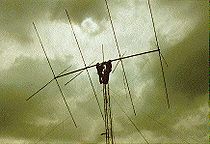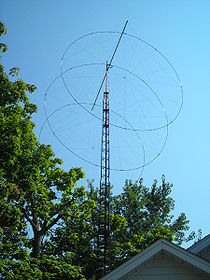
Quad antenna
Encyclopedia


Antenna (radio)
An antenna is an electrical device which converts electric currents into radio waves, and vice versa. It is usually used with a radio transmitter or radio receiver...
which is frequently used by amateur radio
Amateur radio
Amateur radio is the use of designated radio frequency spectrum for purposes of private recreation, non-commercial exchange of messages, wireless experimentation, self-training, and emergency communication...
operators. It consists of a driven element and parasitic elements, like a Yagi
Yagi antenna
A Yagi-Uda array, commonly known simply as a Yagi antenna, is a directional antenna consisting of a driven element and additional parasitic elements...
; however, the elements are square loops. If there is only one parasitic element it is referred to as a 'Cubical Quad' (since it will be an approximate cube).
History
It was developed by Clarence C. MooreClarence C. Moore
Clarence C. Moore was an engineer and minister at Radio Station HCJB with primary transmitters in Quito, Ecuador. He went on to found International Radio and Electronics Corporation in Elkhart, Indiana which was renamed Crown International in the 1960s at the suggestion of his wife Ruby...
(patent no. 2,537,191), W9LZX, an engineer at HCJB
HCJB
HCJB, "The Voice of the Andes", was the first radio station with daily programming in the South American country of Ecuador and the first Christian missionary radio station in the world. The station was founded in 1931 by Clarence W. Jones, Reuben Larson, and D. Stuart Clark.- History :Radio...
(a shortwave missionary radio station high in the Andean Mountains
Andes
The Andes is the world's longest continental mountain range. It is a continual range of highlands along the western coast of South America. This range is about long, about to wide , and of an average height of about .Along its length, the Andes is split into several ranges, which are separated...
). He developed it to resolve issues with large coronal discharges in the thin air with a beam antenna.
Moore describes his antenna as "a pulled-open folded dipole" and describes the time when it was developed:
Moore's design eliminated coronal discharge. "End effect", which is inherent with the Yagi, is absent in a quad because its elements have no ends. But other advantages appeared. The higher impedance, mentioned in the quote above, translates to lower current and thus lower loss on the transmission lines. And gain was found to be higher than that of a Yagi.
Advantages over a Yagi-Uda
Rigorous testing of the quad antenna, reported in William Orr's authoritative "All About Cubical Quad Antennas", and others, have illustrated the following advantages over a Yagi-Uda antenna.Higher Gain
The 2-element Quad has almost the same gain as a 3-element Yagi-Uda: about 7.5 dB over a dipole. Likewise, a 3-element Quad has more gain than a 3-element Yagi-Uda. However, adding quad elements produces diminishing returns. Quoting from William Orr, "Whereas parasitic beams having twenty or thirty parasitic directors are efficient, high gain antennas, it would seem... that maximum practical number of parasitic loop elements for the Quad array is limited to four or five." (Orr, Pg. 48)Radiation Resistance approximately 50Ω
Radiation resistance is affected by antenna height above ground, element spacing, and environmental conditions. However, values will be higher than Yagi's and more closely matched to a 50 Ω coaxial feedLower Boom Height
"A two-element, three-band quad, with elements mounted only 35 feet above ground, will give good performance in situations where a triband Yagi will not." (Page 12-3 of the 15th edition of The ARRL Antenna Book.)Shorter Boom
William Orr's book shows a 10-15-20 meter, 2-element Quad with boom length of 6'10".May be Internally Stacked to form Multi-Band Arrays
As Orr states, interaction between antennas of a multi-band Quad are quite low, even when fed with a single feed line. (Orr, Pg. 63)Lower Angle Radiation
According to K0SR, (pg. 5 of the ARRL's Jan/Feb 2008 National Contest Journal) the claim that quads "open the band earlier", which suggests that they exhibit a lower angle of radiation than Yagis, has persisted for 50 years in spite of the fact that computer models disagree. He posits that the vertical sides of each element actually radiate the low angle component.Broader Bandwidth
The bandwidth for a 3-element Quad antenna that is tuned for maximum gain is limited because excursions from the design frequency unbalance the near resonance condition of the parasitic elements. However, by lengthening the reflector and director elements, thus sacrificing approximately 1 dB gain, the entire 10 meter band may be worked with an SWR below 1.75:1.The E-Z-O variation

- Lower Cost
- Higher Gain
- Lighter in Weight
- Less Wind/Ice Loading
- Easier to Install and Maintain
- Aesthetically Pleasing
The magnitude of the dielectric effect on the outside band elements was surprising. Experimentation was required to establish optimum element lengths. Referencing literature was not to be found. As reported at http://personal.ee.surrey.ac.uk/Personal/D.Jefferies/antennexarticles/diecon.htm, "As far as we are aware, there has been no reported work on encasing loop antennas in dielectric." It appears that "near field" interaction between parallel components increases the magnitude of the dielectric effect. Near field analysis is too complicated for this author.
External links
- EA1DDO Quad antennas page info by EA1DDO.
- Galería de Antenas Cúbicas Large quad antennas gallery.
- N8PPQ N8PPQ's circular quad antenna.

